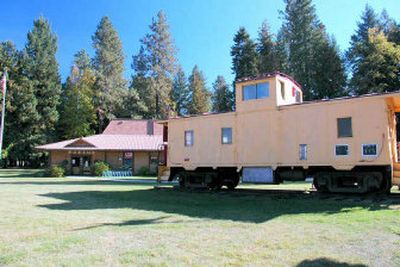A cut above

Mention the word museum, and some people’s eyes will begin to glaze over. Small-town museums bring to mind stuffed birds and counters with glass shelves containing rocks and clothes on display in what used to be a train station or a school. The Bonner County Museum in Sandpoint stands out from the rest.
If you like black-and-white historical photos, there is an excellent display sponsored by the U.S. Forest Service. Some of the prints cross that wonderful line between photography and art. But you have to hurry; the exhibit ends at Thanksgiving.
The photographer, K.D. Swan (1889-1970), had a master’s degree in forestry from Harvard and found a job in Missoula working for the agency in its fledgling years. He was a good forester, but he will be remembered for the photographs he took while working throughout the Rocky Mountain West. Many of his photos on display were taken in North Idaho when the forests were still wild and untamed and reflect Swan’s gifted eye for a great shot.
All that can be found on the second floor of a two-story building, which, unlike many small-town museums, was built to be a museum. Small, local museums like this one are so appealing because the artifacts are not reproductions and they aren’t behind Plexiglas. The visitor is one layer closer to the historical items.
Take stump farming, for example. In the old days timber companies would clear-cut the easy-to-reach timber first on the flatlands around towns, leaving nothing but stumps. Farmers would take over the land and grow crops in the erstwhile forests, selling hay to logging companies to feed the horses used in logging operations.
The caption for a July 31, 1917, photo on display showing a cabin near Sandpoint surrounded by stumps says it best: “Mr. Laird has a fine hay crop this year, raised around the stumps. Enough hay can be cut from around the stumps to pay for the powder to blow the stumps next fall.”
The museum offers interesting displays concerning the Kalispel Tribe, with a historic photo showing two Indians fishing from one of their traditional, distinctive canoes. Between 300 and 400 Kalispels once lived at the mouth of the Clark Fork River. A reproduction of a birch bark canoe is also displayed hauled up on a rocky beach. The seams of the bark were waterproofed with pine sap or pitch.
Information is displayed about the explorer David Thompson who, along with his associate, Finan MacDonald, were the first whites to explore the area. Thompson was a mapmaker and fur trader for the North West Co.
Fur-trade artifacts, including an original buffalo robe, are on display along with information about railroads, steamboats and glacial Lake Missoula.
For those who have a more serious interest in history, whether it is genealogy, train or logging history or historic photos, there is an extensive research archive containing 40,000 photos and newspapers that date from 1899. The research library is open Tuesday, Thursday and Friday from 10 a.m. to 3 p.m.
Thanks to the hard work and money from local people in and around Sandpoint, the Bonner County Museum is a cut above the rest. You won’t have to be poked in the ribs to stay awake in this museum. But try to visit before Nov. 27.